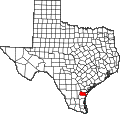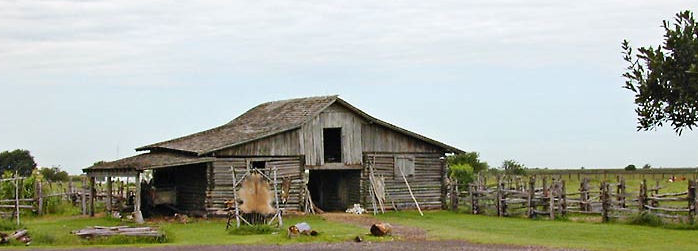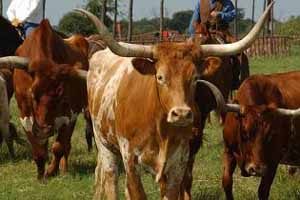

Ranches
SILVA, MANUEL JULIO DE (173?-1798). As a young man, Manuel Julio de Silva became a Franciscan and decided to model his life after that of Antonio Margil de Jesús. Throughout his early years as a priest he was notable for his penitential observances and acts of self-mortification. In later life he punished himself by invariably wearing a shirt of small chain mesh. As a member of the missionary College of Nuestra Señora de Guadalupe de Zacatecas, in August 1790 Father Silva was elected commissary and prefect of the college's missions in Mexico and Texas for a term of seven years. The appointment prompted him to undertake a personal inspection of the establishments for which he was responsible, which took him and a fellow Franciscan, José Francisco Mariano Garza, to Texas in January 1791. Silva, however, was soon ordered back to Mexico to inspect the province of Zacatecas. There he proposed the founding of a mission for the Karankawa Indians on March 10, 1792, the new religious outpost to be located at the mouth of the Guadalupe River. Silva's grandiose plan was to convert all Indian groups between the Mississippi River and the Rio Grande. Unknown to him, Viceroy Revilla Gigedo II had already approved the founding of Nuestra Señora del Refugio Mission on December 31, 1791, thanks to the continued efforts on behalf of the Karankawas by Father Garza in Texas. But in December of the following year, royal expenditures were limited to just this mission.
At that time the great mission era in Texas was rapidly coming to a close. The last mission in Texas was founded in early 1793-just as the older religious establishments at San Antonio were undergoing secularization. Indeed, part of the attractiveness of Silva's plan included reducing the number of missionaries at San Antonio de Valero from four to two and transferring the others to the new mission at the mouth of the Guadalupe. That site, however, proved unhealthful, and an alternate location with the less-than-promising name of Rancho de los Mosquitos was then selected. The second site, about halfway between the confluence of the San Antonio and Guadalupe rivers and the mouth of the latter stream, likewise proved unacceptable, and Father Silva traveled to Mexico in March 1794 to seek more funds for Mission Refugio and authorization for still another change of sites. He returned to the mission in October 1794 and chose the third and present site for Nuestra Señora del Refugio at Rancho Santa Gertrudis. The new location was occupied on January 8, 1795. In the summer of the next year Silva resigned as minister of Refugio Mission, leaving it in the hands of his college. He was then in terrible health. Gout and rheumatism had left him partially paralyzed, he had lost the use of his left hand, and he was unable to bend his knees. In retirement at Zacatecas, Silva lived until December 3, 1798, when he died at the age of sixty-two. By extension it can be argued that he was the founder of the present town of Refugio.
BIBLIOGRAPHY: Carlos E. Castañeda, Our Catholic Heritage in Texas (7 vols., Austin: Von Boeckmann-Jones, 1936-58; rpt., New York: Arno, 1976). William H. Oberste, History of Refugio Mission (Refugio, Texas: Refugio Timely Remarks, 1942).
SANTA PETRONILA RANCH. Santa Petronila was the first Spanish settlement in what is now Nueces County, Texas. It was established in 1762 by Capt. Blás María de la Garza Falcón, founder of Camargo, Nuevo Santander, Mexico. After Governor José de Escandón of Nuevo Santander made two unsuccessful attempts to establish Vedoya, a town on the Nueces River, he commissioned Garza Falcón to found a settlement on the Nueces. Garza Falcón located his ranch five leagues southwest of the bay at the mouth of the Nueces River on Petronila Creek in the vicinity of present Chapman Ranch, due south of the site of future Corpus Christi. He not only brought his family, friends, and servants to Santa Petronila with their belongings and farming and ranching tools, but also brought cattle, horses, mules, sheep, and goats, thus establishing the first ranching and farming industry in Nueces County. By May 2, 1766, Escandón reported to the viceroy of New Spain that a number of settlers were living at Santa Petronila who planted corn and tended to their herds of horses, cattle, and sheep. The ranch was established as an outpost and way station for travelers between the provinces of Nuevo Santander and the missions of East Texas and served as headquarters for expeditions of soldiers who patrolled Isla Blanca (Padre Island), Mustang Island, and St. Joseph's Island searching for settlements by English or French soldiers. In 1766, using Santa Petronila as a base, Lt. José Antonio de la Garza Falcón, son of the ranch founder, was assigned by Escandón to explore the Gulf Coast from the mouth of the Rio Grande to Corpus Christi Bay with twenty-five soldiers looking for evidence of foreign intrusion. In the same year, Col. Diego Ortiz Parrilla was commissioned by the viceroy of New Spain to explore the islands along the lower Texas coast, and he too made Santa Petronila Ranch his headquarters. Other settlers from the Rio Grande villas settled near the Santa Petronila Ranch and acquired Spanish and later Mexican land grants. The livestock brought by the ranchers who settled along the Nueces were allowed to roam and soon became wild, forming large herds of longhorns and mustangs that were abandoned due to the Mexican War of Independence, Indian raids, the Texas Revolution, and subsequent disturbances. The Santa Petronila Ranch was acquired as a part of the Chiltipin land grant in 1835 by Blás María de la Garza Falcón (1803-72), the great-grandson of the captain.
BIBLIOGRAPHY: Herbert Eugene Bolton, Texas in the Middle Eighteenth Century (Berkeley: University of California Press, 1915; rpt., Austin: University of Texas Press, 1970). Carlos E. Castañeda, Our Catholic Heritage in Texas (7 vols., Austin: Von Boeckmann-Jones, 1936-58; rpt., New York: Arno, 1976). Clotilde P. García, Captain Blas María de la Garza Falcón: Colonizer of South Texas (Austin: Jenkins, 1984). Dan Kilgore, Nueces County, Texas, 1750-1800: A Bicentennial Memoir (Corpus Christi: Friends of the Corpus Christi Museum, 1975). WPA Writers' Program, Corpus Christi (Corpus Christi Caller-Times, 1942).

Website designed & maintained by the Nueces County Coordinator


